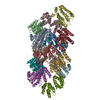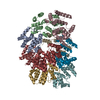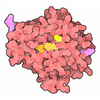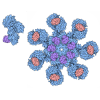+ Open data
Open data
- Basic information
Basic information
| Entry | Database: PDB / ID: 8ym4 | ||||||
|---|---|---|---|---|---|---|---|
| Title | Structure of Caspase-8/cFLIP death effector domain assembly | ||||||
 Components Components |
| ||||||
 Keywords Keywords | APOPTOSIS / FADD / Caspase-8 / cFLIP / death effector domain | ||||||
| Function / homology |  Function and homology information Function and homology informationnegative regulation of myoblast fusion / skeletal muscle atrophy / skeletal myofibril assembly / caspase-8 / syncytiotrophoblast cell differentiation involved in labyrinthine layer development / death effector domain binding / FasL/ CD95L signaling / TRAIL signaling / CD95 death-inducing signaling complex / regulation of skeletal muscle satellite cell proliferation ...negative regulation of myoblast fusion / skeletal muscle atrophy / skeletal myofibril assembly / caspase-8 / syncytiotrophoblast cell differentiation involved in labyrinthine layer development / death effector domain binding / FasL/ CD95L signaling / TRAIL signaling / CD95 death-inducing signaling complex / regulation of skeletal muscle satellite cell proliferation / Apoptotic execution phase / Activation, myristolyation of BID and translocation to mitochondria / ripoptosome / Defective RIPK1-mediated regulated necrosis / Microbial modulation of RIPK1-mediated regulated necrosis / TRAIL-activated apoptotic signaling pathway / TRIF-mediated programmed cell death / Regulation by c-FLIP / CASP8 activity is inhibited / Dimerization of procaspase-8 / regulation of necroptotic process / TLR3-mediated TICAM1-dependent programmed cell death / positive regulation of extracellular matrix organization / self proteolysis / Caspase activation via Death Receptors in the presence of ligand / positive regulation of macrophage differentiation / negative regulation of hepatocyte apoptotic process / positive regulation of glomerular mesangial cell proliferation / response to cobalt ion / skeletal muscle tissue regeneration / positive regulation of hepatocyte proliferation / NF-kB activation through FADD/RIP-1 pathway mediated by caspase-8 and -10 / death-inducing signaling complex / CLEC7A/inflammasome pathway / negative regulation of necroptotic process / regulation of tumor necrosis factor-mediated signaling pathway / tumor necrosis factor receptor binding / death receptor binding / natural killer cell activation / TNFR1-induced proapoptotic signaling / negative regulation of cellular response to transforming growth factor beta stimulus / negative regulation of cardiac muscle cell apoptotic process / RIPK1-mediated regulated necrosis / execution phase of apoptosis / response to anesthetic / regulation of innate immune response / Apoptotic cleavage of cellular proteins / response to testosterone / pyroptotic inflammatory response / response to tumor necrosis factor / B cell activation / macrophage differentiation / positive regulation of proteolysis / extrinsic apoptotic signaling pathway via death domain receptors / positive regulation of execution phase of apoptosis / Caspase-mediated cleavage of cytoskeletal proteins / cellular response to dexamethasone stimulus / negative regulation of extrinsic apoptotic signaling pathway via death domain receptors / skeletal muscle tissue development / negative regulation of reactive oxygen species biosynthetic process / extrinsic apoptotic signaling pathway / negative regulation of canonical NF-kappaB signal transduction / cellular response to nitric oxide / cysteine-type peptidase activity / regulation of cytokine production / proteolysis involved in protein catabolic process / cellular response to epidermal growth factor stimulus / T cell activation / protein maturation / positive regulation of interleukin-1 beta production / negative regulation of extrinsic apoptotic signaling pathway / Regulation of NF-kappa B signaling / apoptotic signaling pathway / cellular response to estradiol stimulus / enzyme activator activity / Regulation of TNFR1 signaling / cellular response to mechanical stimulus / positive regulation of neuron projection development / NOD1/2 Signaling Pathway / protein processing / Regulation of necroptotic cell death / cellular response to insulin stimulus / response to estradiol / peptidase activity / positive regulation of neuron apoptotic process / lamellipodium / heart development / cell body / protease binding / scaffold protein binding / response to ethanol / angiogenesis / response to lipopolysaccharide / cellular response to hypoxia / mitochondrial outer membrane / cytoskeleton / positive regulation of ERK1 and ERK2 cascade / positive regulation of canonical NF-kappaB signal transduction / positive regulation of cell migration / positive regulation of apoptotic process Similarity search - Function | ||||||
| Biological species |  Homo sapiens (human) Homo sapiens (human) | ||||||
| Method |  X-RAY DIFFRACTION / X-RAY DIFFRACTION /  SYNCHROTRON / SYNCHROTRON /  SAD / Resolution: 2.34 Å SAD / Resolution: 2.34 Å | ||||||
 Authors Authors | Lin, S.-C. / Yang, C.-Y. | ||||||
| Funding support |  Taiwan, 1items Taiwan, 1items
| ||||||
 Citation Citation |  Journal: Nat Commun / Year: 2024 Journal: Nat Commun / Year: 2024Title: Reverse hierarchical DED assembly in the cFLIP-procaspase-8 and cFLIP-procaspase-8-FADD complexes. Authors: Chao-Yu Yang / Yi-Chun Tseng / Yi-Fan Tu / Bai-Jiun Kuo / Li-Chung Hsu / Chia-I Lien / You-Sheng Lin / Yin-Ting Wang / Yen-Chen Lu / Tsung-Wei Su / Yu-Chih Lo / Su-Chang Lin /  Abstract: cFLIP, a master anti-apoptotic regulator, targets the FADD-induced DED complexes of procaspase-8 in death receptor and ripoptosome signaling pathways. Several tumor cells maintain relatively high ...cFLIP, a master anti-apoptotic regulator, targets the FADD-induced DED complexes of procaspase-8 in death receptor and ripoptosome signaling pathways. Several tumor cells maintain relatively high levels of cFLIP in achieving their immortality. However, understanding the three-dimensional regulatory mechanism initiated or mediated by elevated levels of cFLIP has been limited by the absence of the atomic coordinates for cFLIP-induced DED complexes. Here we report the crystal plus cryo-EM structures to uncover an unconventional mechanism where cFLIP and procaspase-8 autonomously form a binary tandem DED complex, independent of FADD. This complex gains the ability to recruit FADD, thereby allosterically modulating cFLIP assembly and partially activating caspase-8 for RIPK1 cleavage. Our structure-guided mutagenesis experiments provide critical insights into these regulatory mechanisms, elucidating the resistance to apoptosis and necroptosis in achieving immortality. Finally, this research offers a unified model for the intricate bidirectional hierarchy-based processes using multiprotein helical assembly to govern cell fate decisions. | ||||||
| History |
|
- Structure visualization
Structure visualization
| Structure viewer | Molecule:  Molmil Molmil Jmol/JSmol Jmol/JSmol |
|---|
- Downloads & links
Downloads & links
- Download
Download
| PDBx/mmCIF format |  8ym4.cif.gz 8ym4.cif.gz | 872.7 KB | Display |  PDBx/mmCIF format PDBx/mmCIF format |
|---|---|---|---|---|
| PDB format |  pdb8ym4.ent.gz pdb8ym4.ent.gz | 605 KB | Display |  PDB format PDB format |
| PDBx/mmJSON format |  8ym4.json.gz 8ym4.json.gz | Tree view |  PDBx/mmJSON format PDBx/mmJSON format | |
| Others |  Other downloads Other downloads |
-Validation report
| Summary document |  8ym4_validation.pdf.gz 8ym4_validation.pdf.gz | 700.2 KB | Display |  wwPDB validaton report wwPDB validaton report |
|---|---|---|---|---|
| Full document |  8ym4_full_validation.pdf.gz 8ym4_full_validation.pdf.gz | 714.7 KB | Display | |
| Data in XML |  8ym4_validation.xml.gz 8ym4_validation.xml.gz | 65.1 KB | Display | |
| Data in CIF |  8ym4_validation.cif.gz 8ym4_validation.cif.gz | 84.1 KB | Display | |
| Arichive directory |  https://data.pdbj.org/pub/pdb/validation_reports/ym/8ym4 https://data.pdbj.org/pub/pdb/validation_reports/ym/8ym4 ftp://data.pdbj.org/pub/pdb/validation_reports/ym/8ym4 ftp://data.pdbj.org/pub/pdb/validation_reports/ym/8ym4 | HTTPS FTP |
-Related structure data
| Related structure data |  8ym5C  8ym6C  8yniC  8ynkC  8ynlC  8ynmC  8ynnC C: citing same article ( |
|---|---|
| Similar structure data | Similarity search - Function & homology  F&H Search F&H Search |
- Links
Links
- Assembly
Assembly
| Deposited unit | 
| |||||||||||||||||||||||||||||
|---|---|---|---|---|---|---|---|---|---|---|---|---|---|---|---|---|---|---|---|---|---|---|---|---|---|---|---|---|---|---|
| 1 |
| |||||||||||||||||||||||||||||
| Unit cell |
| |||||||||||||||||||||||||||||
| Noncrystallographic symmetry (NCS) | NCS domain:
|
 Movie
Movie Controller
Controller








 PDBj
PDBj









